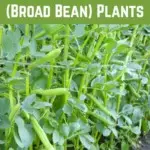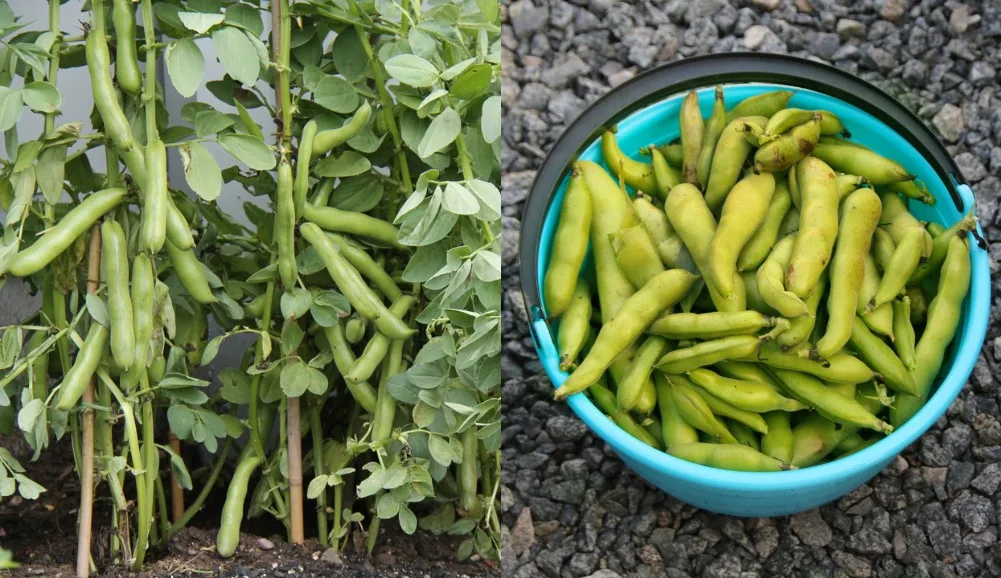
Fava beans, also known as broad beans or faba beans, are an excellent choice for home cultivation. They are particularly beneficial in a cool temperate climate garden. But they can be grown in a wide range of different settings, and so can be a useful plant in many gardens.
If you are not yet growing any of these excellent plants, now could be a great time to start.
In this article, we won’t just explain the basics of growing these beans. We will delve a little deeper to really get to grips with this plant and explore all the different things it can offer.
We’ll talk about what these beans are, why we should grow them. Next, we’ll look at the varieties you can choose to grow, and how to sow them. Then we’ll discuss how to continue to care for your plants as they grow, and what you should grow alongside them. Finally, we’ll talk about how to harvest your beans, and what to do with them once you have.
What Are Fava Beans?
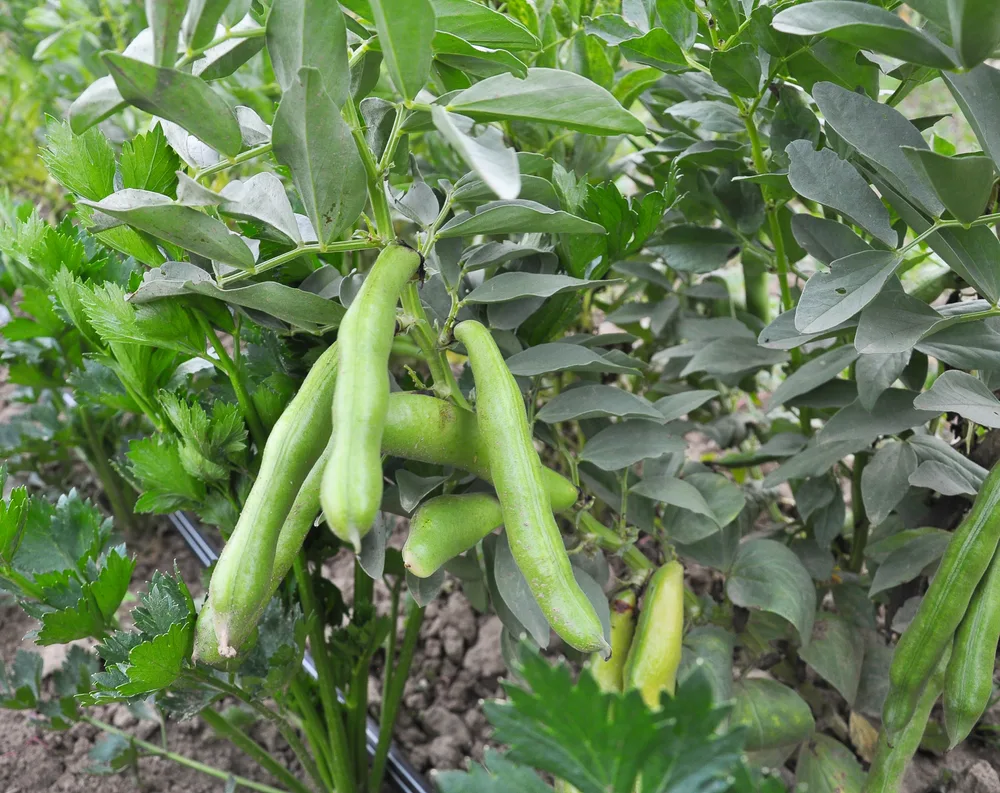
Fava beans, Vicia Faba Major, or broad beans, are a legume and a pulse. They have long been cultivated for their beans (technically seeds) and their original habitat is therefore lost to the mists of time.
They have a long tradition of cultivation in Europe, and elsewhere. It is believed that they became part of the eastern Mediterranean diet around 6000 BCE or even earlier.
The plants are annual, and grow swiftly to an eventual height of over three feet. They form flowers, which contain both male and female organs, and are self fertile and pollinated by bees.
The flowers develop green pods, which grow and develop the seeds inside them. The young pods are tender, but as they mature, they develop a fluffy, fibrous white coating on the inside around the seeds. These seeds can be shelled and eaten when tender and young, or left to mature fully on the plants.
Read on to find out more about ‘broad beans sleeping in their blankety beds’. (Which is a lyric from a traditional harvest song sung by school children in the British Isles.)
Why Grow Fava Beans?
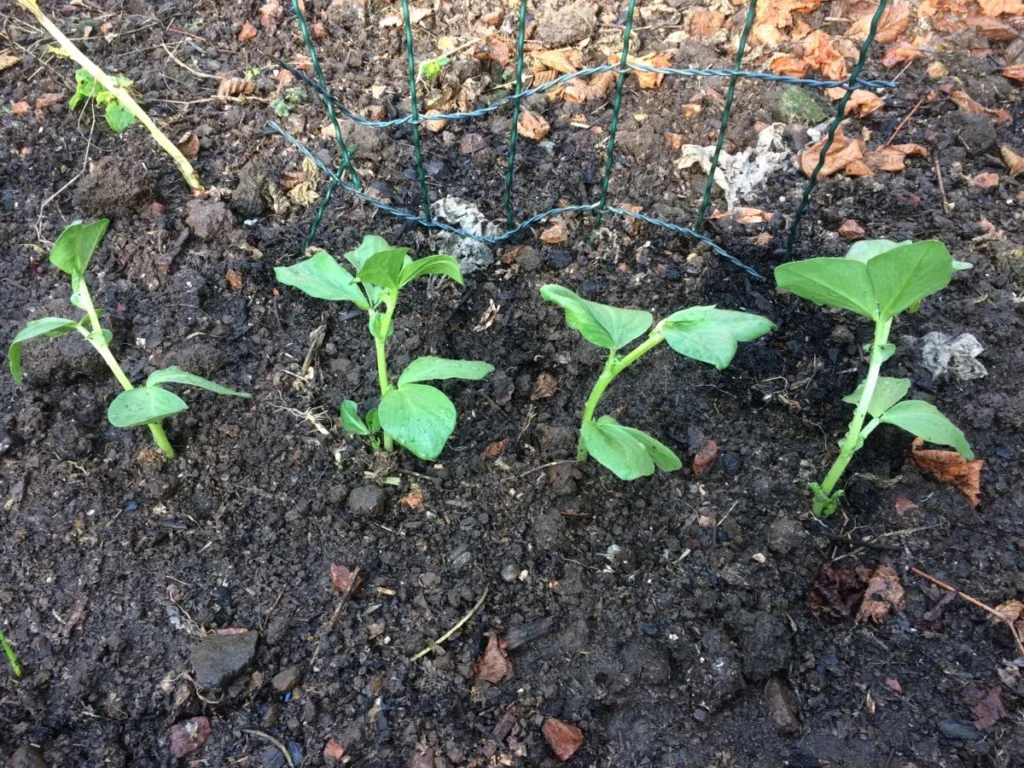
First of all, here are just some of the reasons why growing fava beans is such a good idea:
Fava Beans Are Very Easy to Grow
Fast growing and easy to handle, fava beans are an excellent crop for beginners and children to grow. These plants are relatively forgiving, and easy to sow, and to tend.
When in flower, they can also be a rather decorative and attractive plant, and so could find a place in an ornamental growing area, as well as in a traditional vegetable patch or kitchen garden.
Fava Beans Are a Healthy Food
The beans are a very healthy edible crop to choose. They are high in protein (26% in mature beans), and contain many essential nutrients. For example, 100g of mature beans provides 106% of the daily value for folate.
Fava beans are also moderately rich in other B vitamins and contain dietary minerals such as manganese, phosphorus, iron and magnesium.
The young beans can be eaten fresh, raw in small quantities, or cooked. The mature seeds can also be dried and stored for use throughout the whole year. So this is a crop that can make it easier to grow and eat your own food year round.
The mature seeds can also be ground to make flour, popped, salted and eaten as a snack, or roasted like peanuts. We’ll delve deeper into the many ways to prepare and eat fava beans later in this article. But suffice to say – this is a very versatile ingredient.
Fava Beans Are a Pulse We Can Grow At Home
One interesting thing about broad beans is that they can be eaten green, like a vegetable, or used dried, when they are known as a pulse. Pulses should be an important part of our diets. But they are often neglected by home growers.
Pulses are, perhaps, the most neglected food category when gardeners try to grow their own food. Most home growers focus on fruits, vegetables and herbs. Some may also make forays into grains. If you have a larger homestead or farm, you may keep chickens for eggs, goats or cows for milk, or even livestock for meat.
Whether or not you eat meat, pulses are an important source of protein. They are commonly consumed in the developing world. But in the developed world, we now eat far fewer of them than we should.
Choosing to grow and eat pulses won’t only keep us healthy. It can also allow us to cut down on our meat consumption, and reduce our carbon footprints.
If you are vegetarian or vegan, chances are that you already include pulses in your diet. You may well eat plenty of lentils and chickpeas, for example. But many of the pulses we buy come from far away from where we live. They can be wasteful of water and other resources, grown with harmful pesticides and fertilizers. They likely embody a huge carbon cost, when you take into account how they are grown, and their transportation.
Growing our own pulses, such as fava beans (and other options like other beans, and peas for drying) can help us reduce our carbon footprints and rely on food grown much closer to home. Fava beans are one of the most important pulses grown in cooler temperate climate zones.
They Are Excellent Nitrogen Fixers
As if those benefits for us and the planet were not enough, fava beans are also very good for our gardens. They can bring a range of benefits by helping our gardens to grow strong.
The primary way in which these plants are beneficial in your garden is as ‘nitrogen fixers’. These plants form symbiotic relationships with bacteria that live in their roots, which take nitrogen from the air. Some of this nitrogen is used by the plants themselves. But some remains in the soil, where it can potentially be taken up by other plants grown nearby, or grown after broad beans in the same growing area.
As nitrogen fixers, fava beans can be beneficial when planted alongside, or before, nitrogen hungry plants – including many green, leafy vegetables.
They Can Be Used As a Cover Crop/ Green Manure
Related cultivars of Vicia faba, often called field beans, are predominantly grown for animal feed. But they can also be eaten by humans. Field beans are useful and frequently used in farm crop rotation. They are commonly grown as a cover crop to prepare a growing area for the next crop.
They are used not only for nitrogen fixation but also to protect the soil over winter. All types of fava beans can also be used by gardeners in this way, on a smaller scale. You can use these plants as a cover crop/ winter green manure, to be chopped and dropped once spring arrives.
Planting Fava Beans Creates a Bee-Friendly Habitat
Fava beans, as mentioned above, are self-fertile. Bees are not strictly necessary for fava bean pollination. But studies have shown that fava beans visited by bees to produce higher yields, and better pollination is achieved where pollinating insects are present.
Bees are great for your fava bean harvest. But your fava beans are also a boon for bees.
Broad beans provide bees and other pollinators with a plentiful source of nectar, and planting plenty of them, along with other bee-friendly plants, can help bring them into your garden. Fava beans are particularly beneficial because they can provide a source of nectar early in the year, when there are fewer food sources available for pollinators.
Due to the shape of the flowers, long-tongued bumble bees are the only bees able to get to the nectar in the ‘official’ way. Interestingly, other short-tongued bumble bees like the nectar so much they they are keen to get some too. They are often little thieves, and make a tiny hole at the base of the flower to steal some! Honey bees and other insects will take advantage of these holes and also get some nectar for themselves.
Choosing Fava Beans
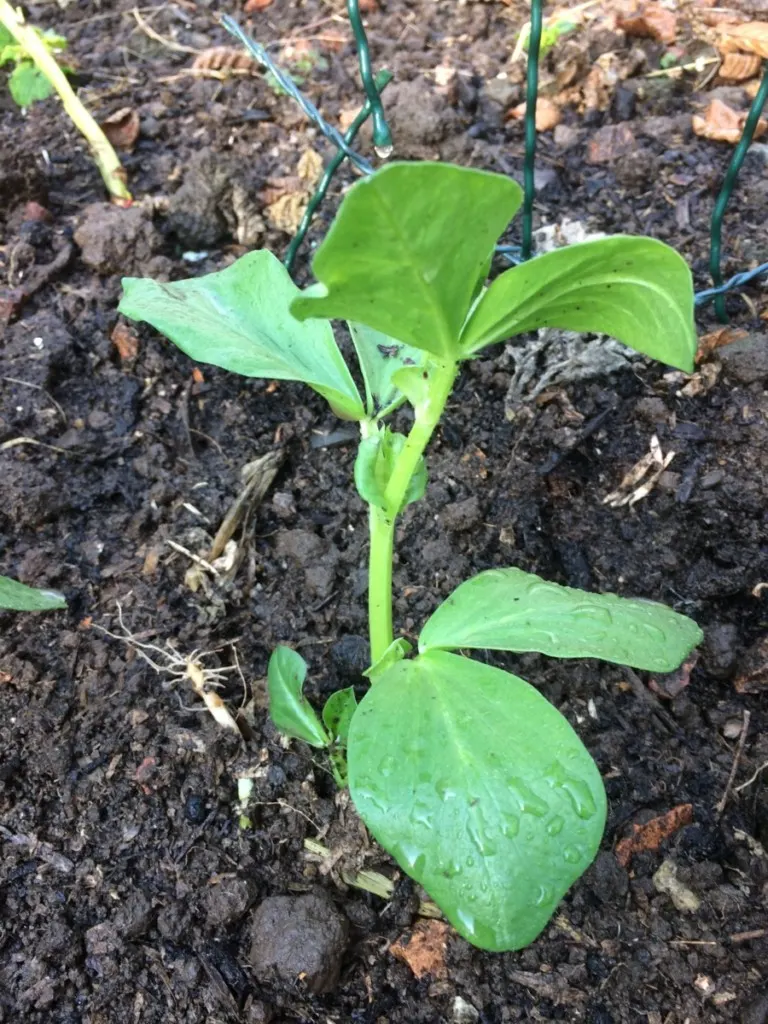
When it comes to choosing fava beans, the most important decision to make will be when to plant. When you are planting will be one of the main factors in determining which type/ variety you should grow. Of course your decision will also be based on the climate and conditions where you live.
Fava beans (Vicia faba major) are generally sown early in spring. However, in certain areas they can also be sown in autumn and overwintered, either as a cover crop/ green manure or to provide a slightly earlier edible crop. The smaller field beans can are also generally a good choice if you plan to plant in fall.
Interesting Varietals:
There are a number of popular named varietals of fava beans. While most can be sown in spring, only certain options are suitable for overwintering.
Aguadulce Long Pod
For overwintering, or for early spring sowing, Aguadulce varietals are a popular choice. The Agua Dulce strain is an heirloom variety that originated in Spain. It can be traced through haba de Sevilla to the late Middle Ages.
It was introduced commercially in the mid-19th Century in some regions but has only been grown in the US much more recently. Agua Dulce has large, broad pods, which usually have 4-5 seeds per pod.
Windsor Long Pod
Another, similar variety is the Windsor varietal. Windsor Long Pod is one of the best varieties in the northern US where summers are cool and relatively short. Heirloom enthusiasts may be interested to know that this is the bean enjoyed by the old American gentry, and was used in popular 18th Century dishes.
Though it came to the US via England, it is originally of Spanish origin and came to England from Portugal in the 1300s. The long pod strain was first introduced commercially in England in 1837. Though there are many different names for different types of Windsors, they all originate with this same strain. Longpods are suitable for fall sowing, while more delicate Windsor varietals are best sown in spring.
Martoc
One other interesting heirloom variety to explore is the Martoc fava. This is believed to be one of England’s oldest strains, and is somewhat a cross between Vicia faba major and field beans. Like a field bean it has fewer beans per pod (generally two). Yet is has favourable taste characteristics when used as a dry bean (pulse).
Wizard Field Bean
If you want to try field beans, ‘Wizard’ is one interesting modern variety that is an excellent choice for particularly cold areas. They can overwinter even in harsh areas where other strains die off, and though the beans are small, and fewer in number, these plants crop over a longer season. They also taste good.
There are, of course, plenty of other varietals to consider. Broad beans can cross easily, so if you wish to save your seeds to plant next year, you should generally grow only one variety.
Sowing Fava Beans
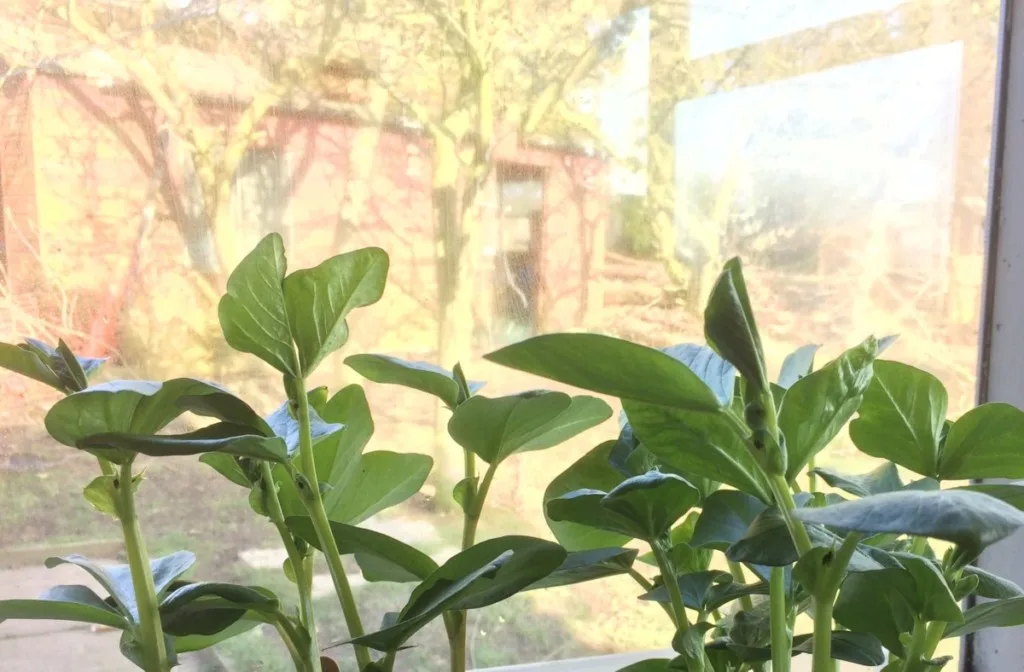
For fall sowings, seeds are sown in around October. In spring, they are generally sown between late February and mid-April, dependant on area, and the climate and conditions where you live.
Fava beans can be sown directly into the soil or the raised bed or container where they are to grow. However, germination, especially for early sowings, can be more reliable if you sow undercover or indoors and then transplant the seedlings to their final position.
One great idea involves sowing broad beans in toilet roll tubes or biodegradable plant pots. You can then transplant your seedlings (in these containers) straight into the ground.
Take a look at our article where Tracey tested out seven of the most popular biodegradable seedling pots you already have around your home. Six worked, one really didn’t.
In chillier areas or where winters can be severe, you will need to provide some form of protection for fall sowings of fava beans. A cloche, row cover, polytunnel/ hoophouse or greenhouse can make it more likely that you will gain an early crop successfully.
Fava beans should be sown (or transplanted into) a fertile area, ideally one with a rich loam soil. Though they can thrive in almost any soil type as long as it is relatively free draining. If you have a particularly heavy clay soil, be sure to amend it with plenty of organic matter before planting, and use transplants rather than sowing seeds directly. If fertility is poor, be sure to add plenty of compost/manure to the site before sowing or transplanting to the growing area.
Depending on varietal, fava beans should be sown around 4-8 inches apart, and if grown in rows, should have a spacing between rows of around 18-24 inches.
In square foot gardening, 4-8 plants can be planted per square foot. Alternatively, it is possible to create abundant polycultures incorporating these useful, nitrogen fixing plants.
Companion Planting and Polycultures
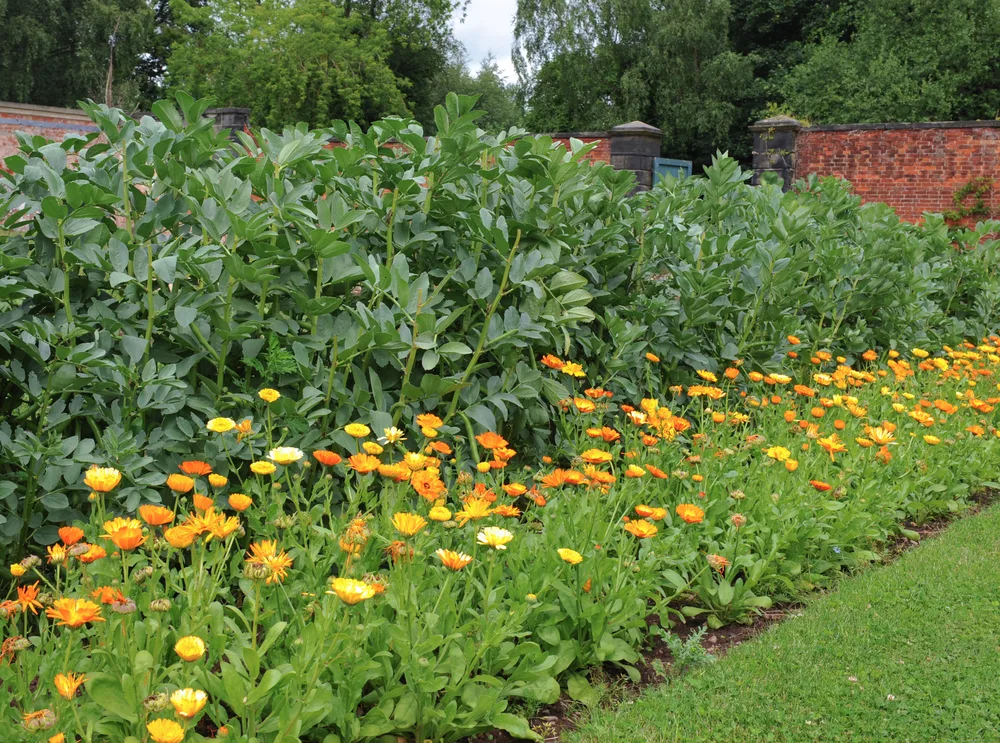
As a nitrogen fixing legume, fava beans are particularly useful in polyculture planting. They can be extremely useful when planted alongside and between a wide range of other plants.
For example, fava beans can be beneficial in the herbaceous layer of a forest garden, in sunny glades and on sunny fringes of fruit tree guilds.
They can also work well in many annual polycultures. For example, good companions for these plants include (but are not limited to):
- potatoes
- brassicas
- spinach, lettuce and other leafy greens
- marigolds
- borage
- summer savory, rosemary, peppermint and other aromatic herbs
However, you should be sure not to plant alliums close to your fava beans.
Growing Fava Beans
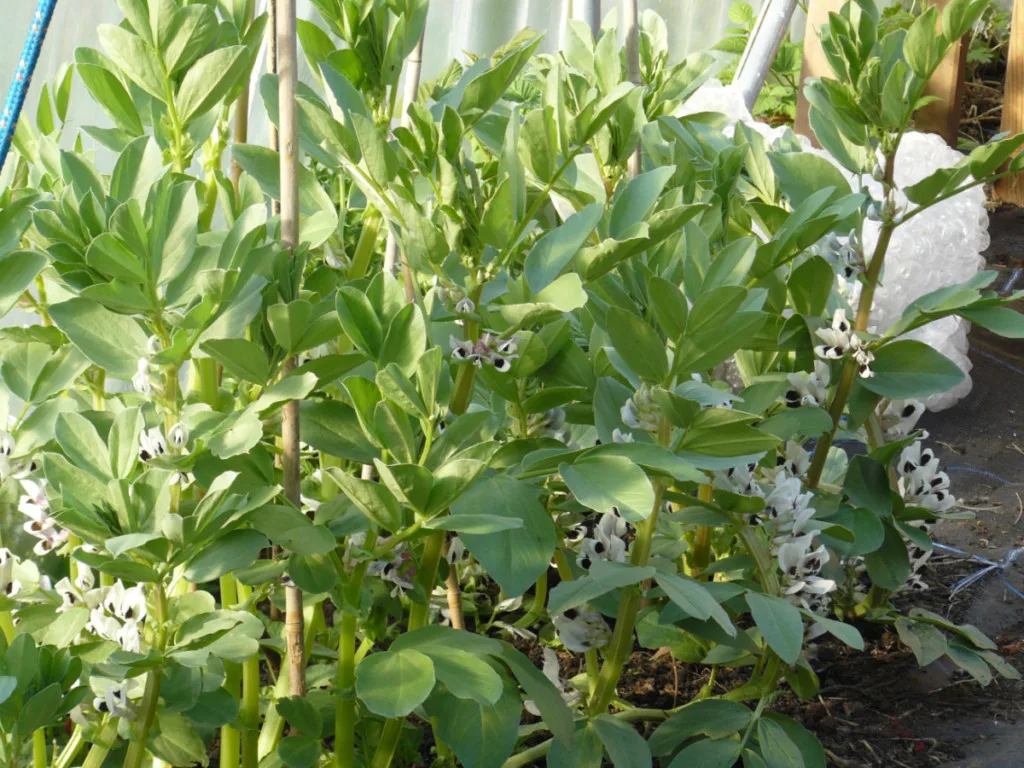
Fava beans are relatively drought tolerant once established. But should be watered in well. It is particularly important to provide plenty of water when they begin to flower, and again (if there has not been sufficient rainfall) around two weeks later.
Taller varietals, or plants grown in more exposed conditions, may need to be staked. Insert a sturdy stake beside each plant and use natural twine to tie the plants onto these supports.
Smaller cultivars will usually support each other when grown sufficiently closely. (However, do not be tempted to plant them too closely as poor air flow can lead to greater problems with pests and disease.)
As soon as the lowest flowering truss has formed small pods, pinch out the growing tips of your plants. This will promote fruit set. (It will also reduce problems with aphids.) Don’t be tempted to throw these tips away. You can stir fry these tips and eat them.
Harvesting Fava Beans
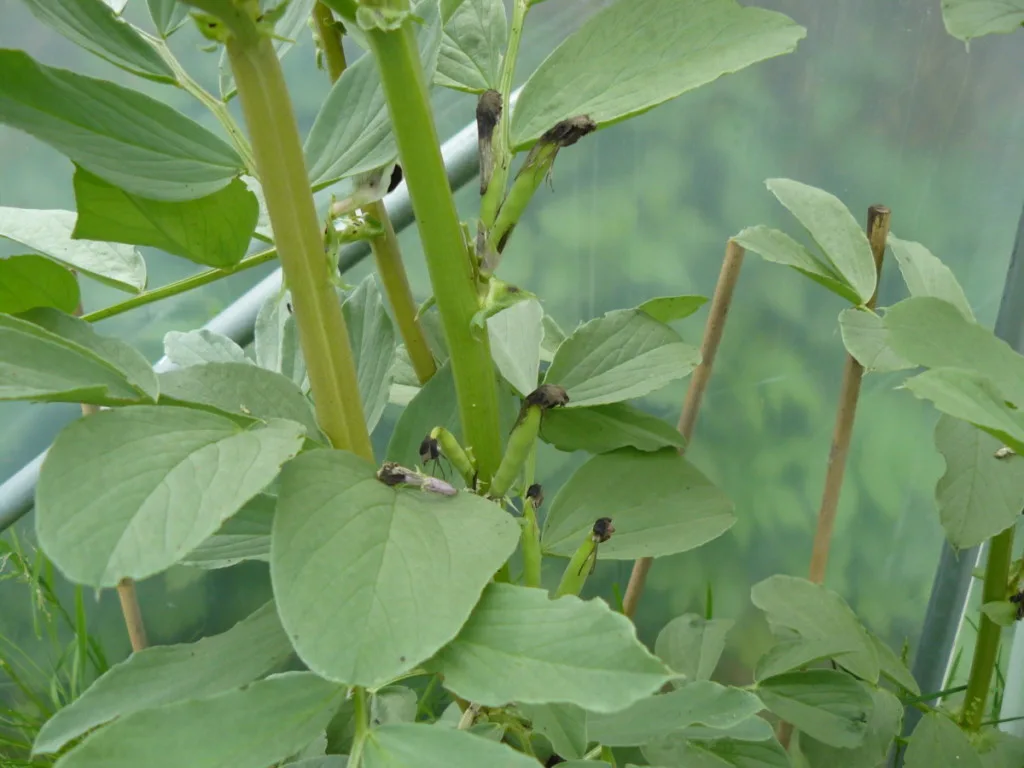
If you plan on eating the beans while they are green, as a vegetable, begin to harvest them once the beans have begun to visibly swell inside their pods. Harvest in stages, beginning with the lowest pods and working your way upwards.
Smaller beans are sweeter and more tender than larger ones, and when picked relatively early, will not need to be skinned. (Sometimes, if picked very young, even the outer pods can be eaten, though usually the beans are taken out of their pods.)
If harvested later, the beans are generally taken from their pods and boiled, then slipped out of their skins.
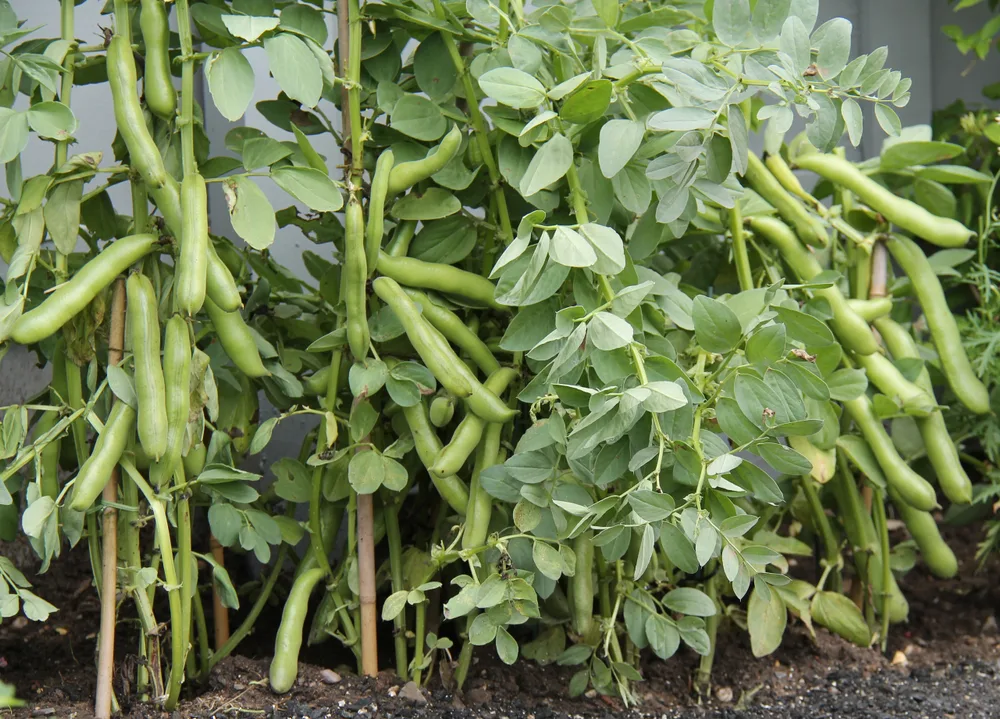
If the fava beans are to be used as a pulse, the beans are left inside their pods on the plants until they are fully mature. They are then shelled, and dried further by being spread out on trays until they are fully hardened before storage. These dried beans can be stored in airtight containers in a cool, dark place, and will be soaked overnight and boiled before eating.
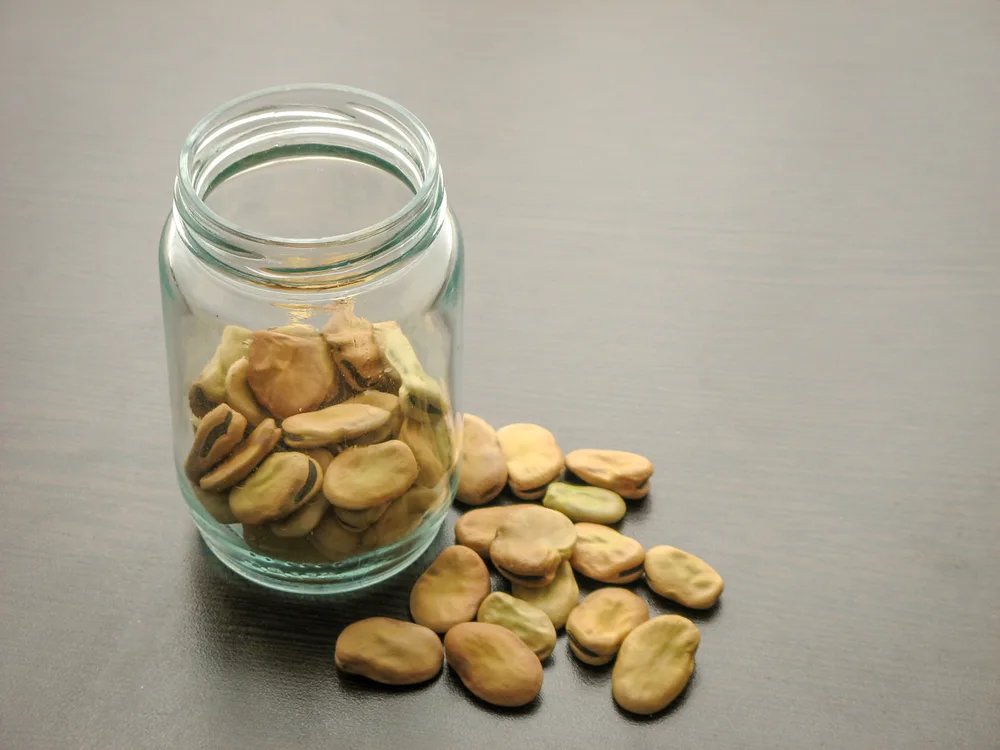
Using Your Beans
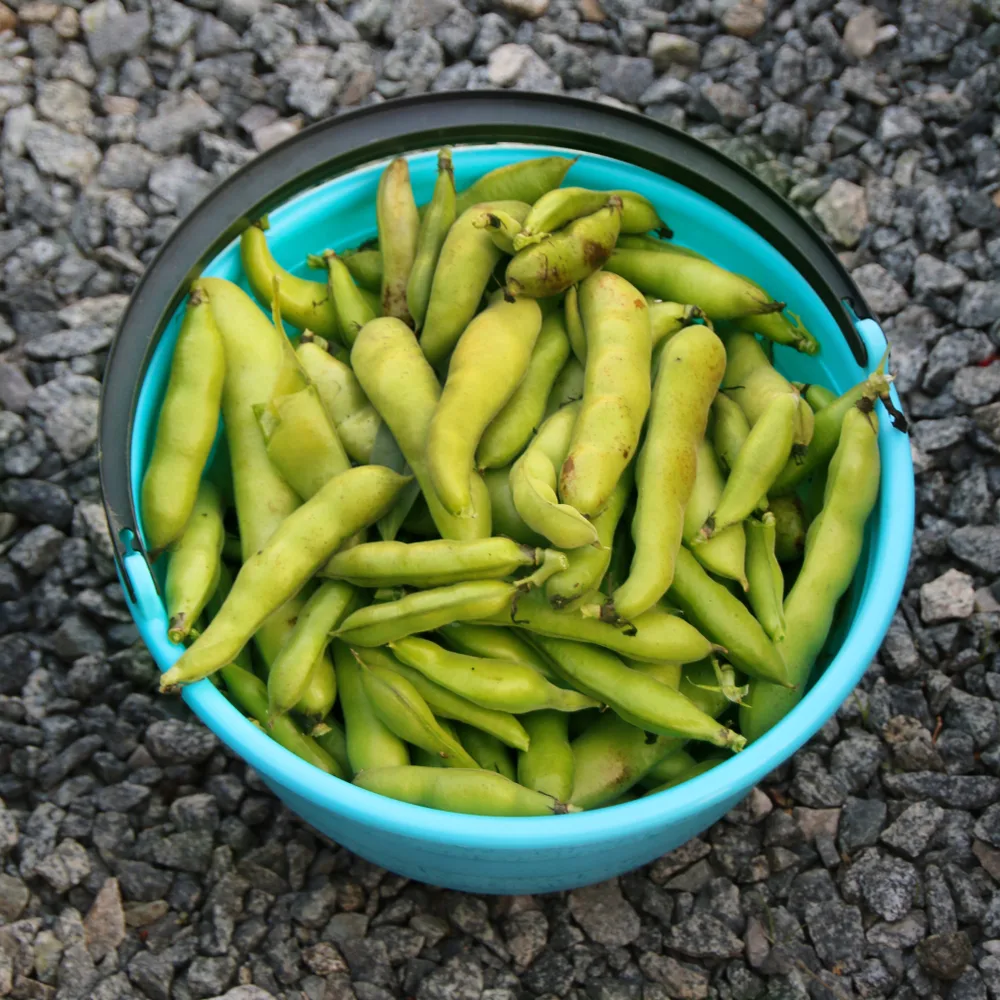
A note on eating fava beans:
Though fava beans are commonly eaten around the world, they can cause the disease Favism in certain susceptible people. (Even inhaling the pollen can cause this problem for some people.) Favism is a severe haemolytic anaemia which is caused by an inherited enzymatic deficiency.
Fava beans, for those who can eat them, are a truly versatile ingredient, however. And, as mentioned above, an extremely healthy one.
Eating Young Tender Fava Beans
Young and tender fava beans can be eaten raw in small quantities. Very young beans do not necessarily need to be shucked from their skins. Slightly older beans, boiled for two minutes, can then be slipped out of their outer membrane. They can then be added to fresh spring salads and a range of other recipes.
Pea, Asparagus and Fava Bean Salad @ bonappetit.com.
Buttered Fava Bean Salad @ naturallyella.com.
Broad Bean Bruscetta @ bbcgoodfood.com.
Eating Mature Fava Beans
As beans mature, they can still be used as a vegetable, but are best cooked for longer and used in soups, stews and other recipes with somewhat longer cooking times. Here are a few excellent examples:
Fava Bean and Vegetable Soup @ cooking.nytimes.com.
Bean Stew @ saveur.com.
Fava Bean and Cauliflower Risotto @ foodandwine.com
Using Dried Fava Beans as a Pulse
Fava beans, once dried, can be soaked overnight and then boiled, and used as in the recipes above. But these dried beans can also be used to make fava bean flour. You can also soak, boil and dry roast your dried fava beans.
Dry-Roasted Broad Beans @ elliesskinnycookbook.blogspot.
Of course, there are plenty more ways to use them. These are just a few of the many examples out there to help you make the most of your fava bean harvest.
If you do not already grow fava beans where you live – it could be time to add this useful crop to your garden.

Get the famous Rural Sprout newsletter delivered to your inbox.
Including Sunday musings from our editor, Tracey, as well as “What’s Up Wednesday” our roundup of what’s in season and new article updates and alerts.


